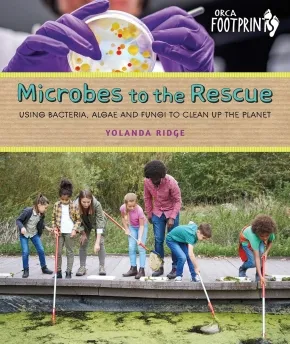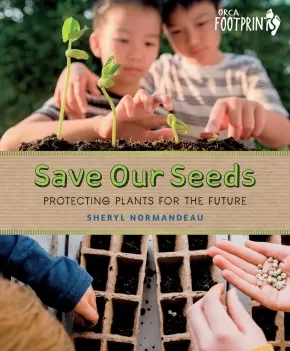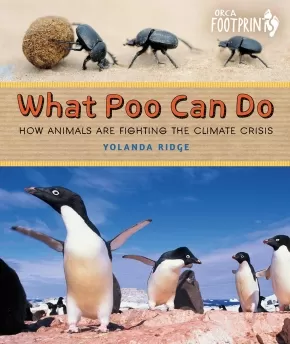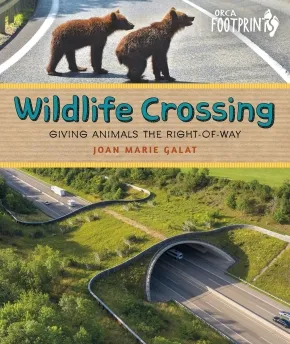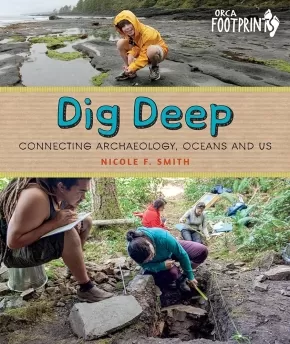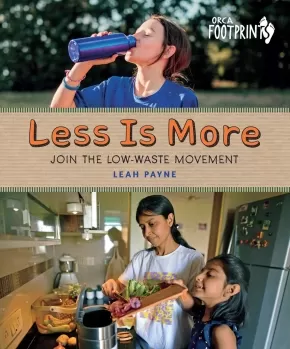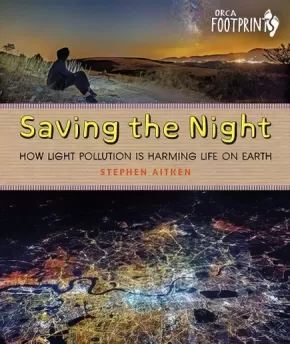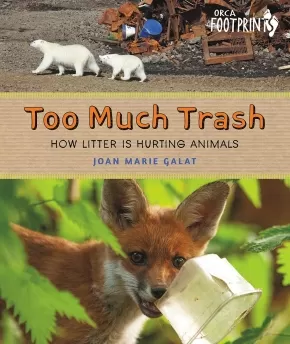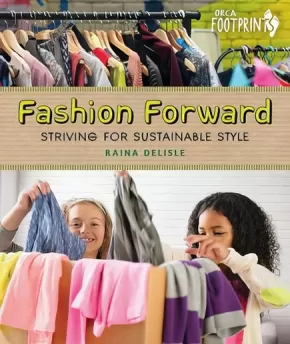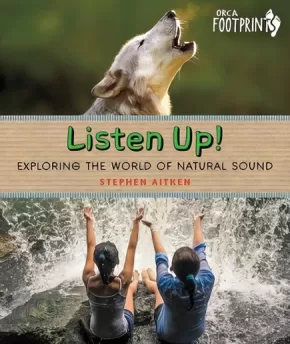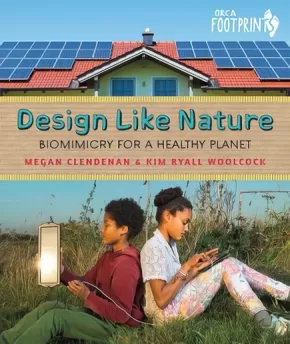Orca Footprints
Kids today inhabit a world full of complex—and often mystifying—environmental issues. Orca Footprints aim to help kids answer their questions about the state of the natural world with well-researched, simply-expressed information and powerful images. With topics such as food production, water, cycling and sustainable energy, these books will inspire kids to take action.
Synopsis:
Microbes are tiny but mighty, and they're everywhere!
When left alone, microbes such as bacteria, fungi and algae are experts at adapting, surviving and thriving under extreme and constantly changing conditions. These natural problem solvers can help fight the climate crisis by gobbling up pollutants, breaking down plastic, generating clean energy and capturing carbon. By harnessing the power of microbes, we can create eco-friendly packaging, farm-free food, and even make it easier to live in space! Microbes to the Rescue will introduce young readers to life on a microscopic level and explore how bacteria, fungi and algae play a key role in the connection between all life on Earth. Let’s get microscopic and learn about how microbes can create a cleaner and more sustainable future.
Educator & Series Information
Recommended for ages 9 to 12.
This book is part of the Orca Footprint series.
Reading Levels:
Fountas & Pinnell Text Level Gradient: X
Lexile measure: 1110L
Guided Reading Level: X
Additional Information
56 pages | 8.00" x 9.50"| Includes 63 colour photographs, 1 index, 1 bibliography | Hardcover
Synopsis:
We have a serious plastic problem.
What was supposed to be a miracle material when it was first invented is now one of the biggest sources of pollution on our planet. But where does plastic come from? Why do we use so much of it? How does it hurt the environment and the animals who live there? Our Plastic Problem looks at plastic's history, uses, and how it affects land, water, air and human health. It also explores innovations in bioplastic and recycling, and practical ways to reduce and replace the plastic in our lives. Working together, we can solve our plastic problem.
Reviews
“Like other books in the Orca Footprints series, this volume is accessible, broadly informative, and illustrated with many pertinent color photos. A timely introduction to a serious environmental issue.” — Booklist
“Durnford effectively communicates a sense of urgency. Young eco-activists will also find general guidelines for localized projects, as well as specific instructions for laundering clothing to reduce microfibre shedding, among other immediately applicable advice. Accentuates the positive without minimizing the issue’s scope.” — Kirkus Reviews
Educator & Series Information
Recommended for ages 9 to 12.
This book is part of the Orca Footprint series.
Reading Levels:
Fountas & Pinnell Text Level Gradient: X
Lexile measure: 1070L
Guided Reading Level: X
Additional Information
48 pages | 8.00" x 9.50" | Includes 78 colour photographs, 1 index, 1 bibliography | Hardcover
Synopsis:
We know spending time in nature is good for us, but why? And how did people become so disconnected from the natural world, anyway?
Get Outside! How Humans Connect with Nature explores the important relationship between people and nature. It asks big questions, like Are humans part of nature or separate from it? and Do all people have equal access to nature? By discussing global issues such as the climate crisis and environmental racism, the book shows us that, by strengthening our relationship with the natural world, we can learn how to take care of the environment and to let the environment take care of us too.
Reviews
“Payne argues that humans are part of nature and should be engaging with the natural world more often and more effectively…Informative and likely to spur readers to forge a stronger bond with the natural world.”— Kirkus Reviews
“The text is visually striking…This book should appeal to readers interested in or curious about the outdoors and could lead to deeper engagement or activism.”— School Library Journal (SLJ)
Educator & Series Information
Recommended for ages 9 to 12.
This book is part of the Orca Footprint series.
Reading Levels:
Fountas & Pinnell Text Level Gradient: X
Lexile measure: 1030L
Guided Reading Level: X
Additional Information
48 pages | 8.00" x 9.50" | Includes 49 colour photographs, 1 index, 1 bibliography | Hardcover
Synopsis:
Small but mighty. Learn about the importance of seeds and how saving and conserving them for the future is key to sustaining healthy life on the planet.
Seeds are essential to all life on the planet. They provide us with food, clothing and other materials we need and use every day. Without seeds, the planet wouldn't have as many species of plants as we do now. Without plants, there wouldn't be oxygen to breathe and there would be less food for all life on Earth. But today seeds are under threat, mostly from human activity. The climate crisis and food insecurity mean protecting our seeds is more important than ever. In Save Our Seeds, young readers will hear from experts in the field and learn how to take action to preserve seeds for the future.
Reviews
“The latest volume in the well-regarded Orca Footprints series presents a broad array of information about seeds…Exploring seeds more broadly than most children’s books on the topic, this volume encourages readers to collect, plant, and share seeds—a small, yet powerful resource.”- Booklist
“Author and master gardener Sheryl Normandeau… emphasizes the importance of saving and conserving seeds for the future in order to sustain healthy life on Earth. Highly Recommended.”- CM: Canadian Review of Materials
Educator & Series Information
Recommended for ages 9 to 12.
This book is part of the Orca Footprint series.
Reading Levels:
Fountas & Pinnell Text Level Gradient: X
Lexile measure: 1040L
Guided Reading Level: X
Additional Information
48 pages | 8.00" x 9.50" | Includes 60 colour photographs, 1 index, 1 bibliography | Hardcover
Synopsis:
We all know animals are affected by the climate crisis. But did you know the climate crisis is also affected by animals?
From whales to dung beetles, What Poo Can Do explores how animals big and small are helping the planet every time they do a number two. Come on a journey to different parts of the world to see how animals are fertilizing plants, storing carbon, preventing fires, reducing methane and even creating color-coded maps—all through their feces! Readers will discover how animal defecation makes a difference when it comes to the climate crisis. It's time to embrace the power of poo!
Reviews
“Well-organized and sustains the reader’s interest…Highly recommended.”— CM: Canadian Review of Materials
“While most environmental titles for children focus on how humans can protect and care for the planet, this book focuses on animals who are already assisting the cause—with poop!”— Booklist
Educator & Series Information
Recommended for ages 9 to 12.
This book is part of the Orca Footprint series.
Reading Levels:
Fountas & Pinnell Text Level Gradient: X
Lexile measure: 1090L
Guided Reading Level: X
Big Ideas & Themes: Environmental Awareness, Climate Change, Environmental Conservation & Protection, Green Issues, Sustainability, Wildlife
Additional Information
48 pages | 8.00" x 9.50" | Includes 41 colour photographs, 1 diagram, 1 index, 1 bibliography | Hardcover
Synopsis:
What happens when the needs of people and nature collide?
More than 13 million miles of roads crisscross landscapes in 222 countries. Roads offer many human benefits, but they also create problems for nature. Their construction leads to a loss of biodiversity through habitat loss, fragmentation and degradation. Roads isolate wildlife populations, impede migration and allow invasive plant and animal species to spread, while giving rise to pollution from garbage, light, noise and airborne contaminants. With innovative tools, like wildlife overpasses to reconnect landscapes, smart roads and vehicles to maximize safety, and a little hands on help, we can create environmental harmony. And sitting in the passenger seat, young people can play a part in helping highways and habitats coexist.
Reviews
“Well organized and includes clearly explained examples from many locations…This volume offers considerably more information for students researching the topic. An intriguing subject and a good resource for middle-grade reports.”— Booklist
“Gorgeous, crisp photographs complement the well-written text…A first purchase for libraries that need more books on the topic of conservation and the impact of development on wildlife.” — School Library Journal (SLJ)
“A fascinating, invaluable and enlightening tool for libraries, schools and homes alike. Wildlife Crossing will empower all readers to do their part when it comes to road ecology and will undoubtedly spark meaningful conversations about what it means to coexist with nature. Very highly recommended.”— Canadian Children's Book Centre (CCBC) Canadian Children’s Book News
“Wildlife Crossing gives an intriguing overview of the topic in just 48 pages, but it is a good addition to science collections with a focus on the environment. Highly Recommended.”— CM: Canadian Review of Materials
Educator & Series Information
Recommended for ages 9 to 12.
This book is part of the Orca Footprint series.
Reading Levels:
Fountas & Pinnell Text Level Gradient: X
Lexile measure: 1130L
Guided Reading Level: X
Additional Information
48 pages | 8.00" x 9.50" | Includes 74 colour photographs, 1 index, 1 bibliography | Hardcover
Synopsis:
What can archaeology and Indigenous Traditional Knowledge tell us about how our marine environments have changed over time and the effects of climate change?
From harvesting herring eggs to hunting humpback whales, humans have had a relationship with the world's oceans for more than 100,000 years. In Dig Deep: Connecting Archaeology, Oceans and Us, young readers unearth what our ancestors left behind at archaeological sites around the world and examine how tools, campsites, fishing technologies and even garbage can show us how our ancestors lived and how they used the ocean. These discoveries can unearth clues to help keep our oceans healthier today and in the future.
Reviews
“Provides readers with an introduction to archeology…Slim yet informative…Recommended.” — School Library Connection
Educator & Series Information
Recommended for ages 9 to 12.
This book is part of the Orca Footprint series.
Additional Information
48 pages | 8.00" x 9.50" | Hardcover
Synopsis:
All over the world, people are joining the low-waste movement and getting tough on their trash.
Maybe you’ve heard the reports of the Great Pacific Garbage Patch swirling in the ocean. Maybe you’ve seen the photos of whales and sea birds with trash in their bellies. Or maybe you’ve heard that only 9 percent of our plastic waste actually gets recycled.
We can all do our part for the planet by creating less garbage. In Less Is More young readers will discover how to avoid waste in the first place, reduce how much they use and reuse what they can, before they recycle and rot (compost) the rest. With small, simple actions we can become part of the circular economy. Find out how you can join the low-waste movement—and get your friends and family on board too!
Educator & Series Information
Recommended for ages 9 to 12.
This book is part of the Orca Footprint series.
Additional Information
48 pages | 8.00" x 9.50" | 51 Colour Photos, 3 Colour Tables, 2 Diagrams, 1 Index, 1 Bibliography | Hardcover
Synopsis:
Light pollution threatens the survival of every living species on our planet, including people.
It started when Thomas Edison invented the first light bulb more than 150 years ago. Then, as electric light became more common, light pollution began to take over cities and towns. Today, in urban centers all over the world, the stars in the sky aren't visible. Millions of people have never seen the Milky Way. In Saving the Night, we discover how plants and animals have adapted over millions of years to survive and thrive in the dark, and how artificial light can upset the balance of entire ecosystems. But there are ways we can take back the night for animals, plants and us. It starts with the flick of a switch.
Reviews
“Richly described and alluring…Aitken urges his readers to be unafraid of the dark and after reading this excellent book, tweens will want to venture forth into the night without a flashlight.”— School Library Journal
“Both personal and poetic…A very comprehensive look at the role of light in the natural world and the effect of light pollution on all living organisms. This book deserves to be available and promoted in schools and libraries. Saving the night for all of us is worth it. Highly Recommended.” — CM: Canadian Review of Materials
“[An] informative addition to the Footprints series…This organized, involving book will fill a gap in many library collections.”— Booklist
“Flashes on a too often unconsidered sort of environmental pollution.”— Kirkus Reviews
Educator & Series Information
This book is part of the Orca Footprint series. Kids today inhabit a world full of complex—and often mystifying—environmental issues. Orca Footprints aim to help kids answer their questions about the state of the natural world with well-researched, simply-expressed information and powerful images. With topics such as food production, water, cycling and sustainable energy, these books will inspire kids to take action.
Recommended for ages 9-12.
Additional Information
48 pages | 8.00" x 9.50" | Hardcover
Synopsis:
Litter is not only an eyesore but a serious threat to animals and their habitats. We can all work together to keep the planet healthy and clean.
Did you know that gum on the sidewalk is litter? Even a banana peel that is thrown in a ditch is litter. Trash poses a threat to animals everywhere, including pets, farm animals and wildlife. They can get injured or trapped in the litter and even eat garbage that makes them sick.
In Too Much Trash: How Litter Is Hurting Animals, we discover how garbage ends up everywhere—from city streets and the wilderness to farmland and the ocean. But there's good news: litter is a problem everyone can help prevent. Around the world, kids and adults are finding ways to take out the trash. Find out how you can help clean up the planet for all species.
Reviews
“Lively design layouts with discrete, digestible bits of text make the book accessible and inspiring. Showing how refuse harms humans and other animals, this work should move readers to act.” — Kirkus Reviews
Educator & Series Information
This book is part of the Orca Footprint series. Kids today inhabit a world full of complex—and often mystifying—environmental issues. Orca Footprints aim to help kids answer their questions about the state of the natural world with well-researched, simply-expressed information and powerful images. With topics such as food production, water, cycling and sustainable energy, these books will inspire kids to take action.
Recommended for ages 9-12.
Additional Information
48 pages | 8.00" x 9.50" | Hardcover
Synopsis:
In the developed world, if you want a drink of water you just turn on a tap or open a bottle. But for millions of families worldwide, finding clean water is a daily challenge, and kids are often the ones responsible for carrying water to their homes. Every Last Drop looks at why the world’s water resources are at risk and how communities around the world are finding innovative ways to quench their thirst and water their crops. Maybe you’re not ready to drink fog, as they do in Chile, or use water made from treated sewage, but you can get a low-flush toilet, plant a tree, protect a wetland or just take shorter showers. Every last drop counts!
Reviews
"This engaging book takes on the important task of explaining clean drinking water to middle school students...The writing style is a very accessible mixture of personal travel stories and interesting facts ..It can be hard to find good books on sustainability issues for middle school students. This well-written book will be a welcome addition to any classroom or library collection. It will support any research on water usage and will be popular with students interested in getting involved with environmental issues. Highly Recommended." — CM Magazine
"Mulder’s book will make readers stop and calculate...Lavishly illustrated with everything from woodcuts to photographs, the book is far from downbeat and scolding...Mulder writes with a clean, no-nonsense style...Informative, attractive and alarming—readers will think twice before leaving the water running as they brush their teeth." — Kirkus Reviews
Educator & Series Information
Recommended for ages 9 to 12.
This book is part of the Orca Footprints series. Kids today inhabit a world full of complex—and often mystifying—environmental issues. Orca Footprints aim to help kids answer their questions about the state of the natural world with well-researched, simply-expressed information and powerful images. With topics such as food production, water, cycling and sustainable energy, these books will inspire kids to take action.
Additional Information
48 pages | 8.00" x 9.50" | Paperback
Synopsis:
Fashion can be fun, but it can also hurt people, animals and the planet.
Fashion Forward: Striving for Sustainable Style goes behind the glitz and glamour to explore the social and environmental issues within the fashion industry. It looks at the history of fashion, from why humans started wearing clothes to the birth of consumerism to the explosion of fast fashion and fashion’s footprint. The book introduces readers to the innovative people, companies and organizations that are taking positive action on fashion. Kids will discover how to make ethical choices and become fashion heroes for the future. There are easy ways we can help transform the fashion industry and still look stylish at the same time!
Reviews
“This book will inform and engage the middle school readers for whom it is written as well as younger and older readers looking for sustainable alternatives to fast fashion, and it will encourage all readers to make a difference by thinking critically before making clothing decisions. Highly Recommended.” — CM: Canadian Review of Materials
Educator & Series Information
Recommended for ages 9 to 12.
This book is part of the Orca Footprint series.
Additional Information
56 pages | 8.00" x 9.50" | Hardcover
Synopsis:
The sounds of nature are being drowned out by the clamor of human activity, and that's not good for people, animals or the environment.
Every living thing emits sound—birds sing, whales whistle, streams burble and trees pop and fizzle. In Listen Up, young readers are introduced to all the sounds of the natural world, from the first Big Bang to the complex soundscapes of the rainforests.
Readers will also discover how the invasion of human sounds, from airplanes, traffic and machines, is threatening the survival of species that have adapted to their habitats over thousands of years. Conserving the sounds of nature is an important part of addressing the biggest challenges facing humanity today—protecting the planet's biodiversity and the future of our natural world.
Reviews
“Engages readers by bringing together a series of interesting facts and ideas related to animal hearing…An intriguing addition to the Orca Footprints series.”— Booklist
Educator & Series Information
Recommended for ages 9 to 12.
This book is part of the Orca Footprint series.
Additional Information
56 pages | 8.00" x 9.50" | Hardcover
Synopsis:
Did you know that lamps can be powered by glowing bacteria instead of electricity? That gloves designed like gecko feet let people climb straight up glass walls? Or that kids are finding ways to make compostable plastic out of banana peels? Biomimicry, the scientific term for when we learn from and copy nature, is a revolutionary way to look to nature for answers to environmental problems such as climate change.
In Design Like Nature young readers discover innovations and inventions inspired by the environment. Nature runs the entire planet with no waste and no pollution. Can humans learn to do this too? It's time to step outside and start designing like nature.
Educator & Series Information
Recommended for ages 9 to 12.
This book is part of the Orca Footprint series. Kids today inhabit a world full of complex—and often mystifying—environmental issues. Orca Footprints aim to help kids answer their questions about the state of the natural world with well-researched, simply-expressed information and powerful images. With topics such as food production, water, cycling and sustainable energy, these books will inspire kids to take action.
A free, downloadable scavenger hunt activity is available: Scavenger Hunt - Design Like Nature: Biomimicry for a Healthy Planet
Additional Information
48 pages | 8.00" x 9.50"
Synopsis:
Plants, animals, insects and fish are moving in. Invasive species threaten local ecosystems and the planet’s biodiversity, but are they all as bad as we think they are? In Nature Out of Balance: How Invasive Species Are Changing the Planet author Merrie-Ellen Wilcox profiles all-star invasive species around the world, starting in her own neighbourhood, and warns that humans are the most invasive species of all. We find out how and why species become invasive, what we can do to stop their spread and whether it’s time to think differently about invasive species that are here to stay.
Reviews
“A well-written volume on a distinctly important topic for youngsters to be aware of as they grow into their role of guardians of the ecosystems. Highly Recommended.” — CM: Canadian Review of Materials
“The balance of hope against the potentially stressful subject leaves readers informed and energized rather than defeated. Handy and lucid, this slim volume makes an important topic digestible.” — Kirkus Reviews
“A high-quality introduction to a topic not often covered in books for middle graders.” — School Library Journal
Educator & Series Information
This book is part of the Orca Footprint series. Kids today inhabit a world full of complex—and often mystifying—environmental issues. Orca Footprints aim to help kids answer their questions about the state of the natural world with well-researched, simply-expressed information and powerful images. With topics such as food production, water, cycling and sustainable energy, these books will inspire kids to take action.
In Nature Out of Balance, we find out how and why species become invasive and practical tips about what we can do to stop their spread.
Globalization means that new invasive species are being found around the world every day, threatening the biodiversity of our neighborhoods, cities, countries and the planet as a whole.
The author has studied ecological restoration and examines invasive species starting in her own backyard.
This book offers a unique perspective on invasive species and how it might be time to rethink how we coexist with them.
Invasive species are often described as the most overlooked environmental threat in the world (in the US they cause $120 billion a year in damage, in BC alone they cost farmers $50 million a year).
Recommended for ages 9 to 12
Additional Information
48 pages | 8.00" x 9.50"

